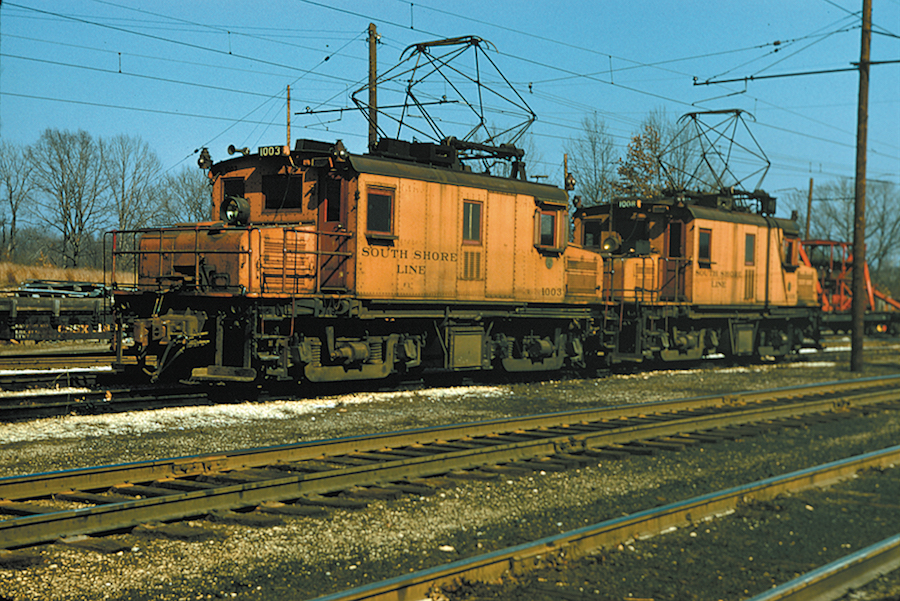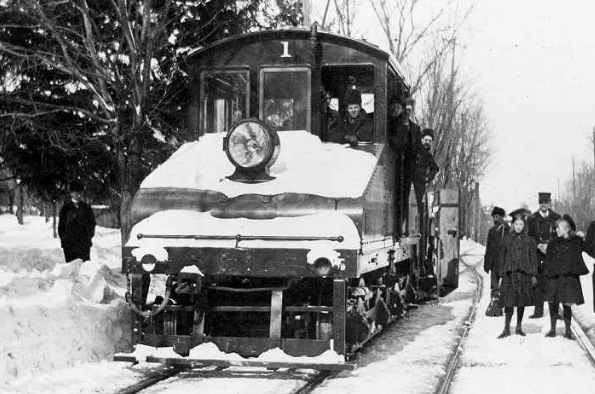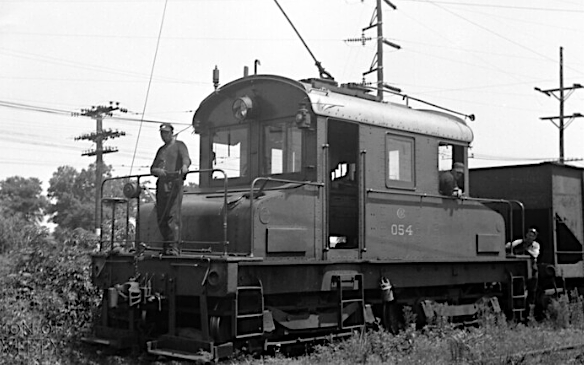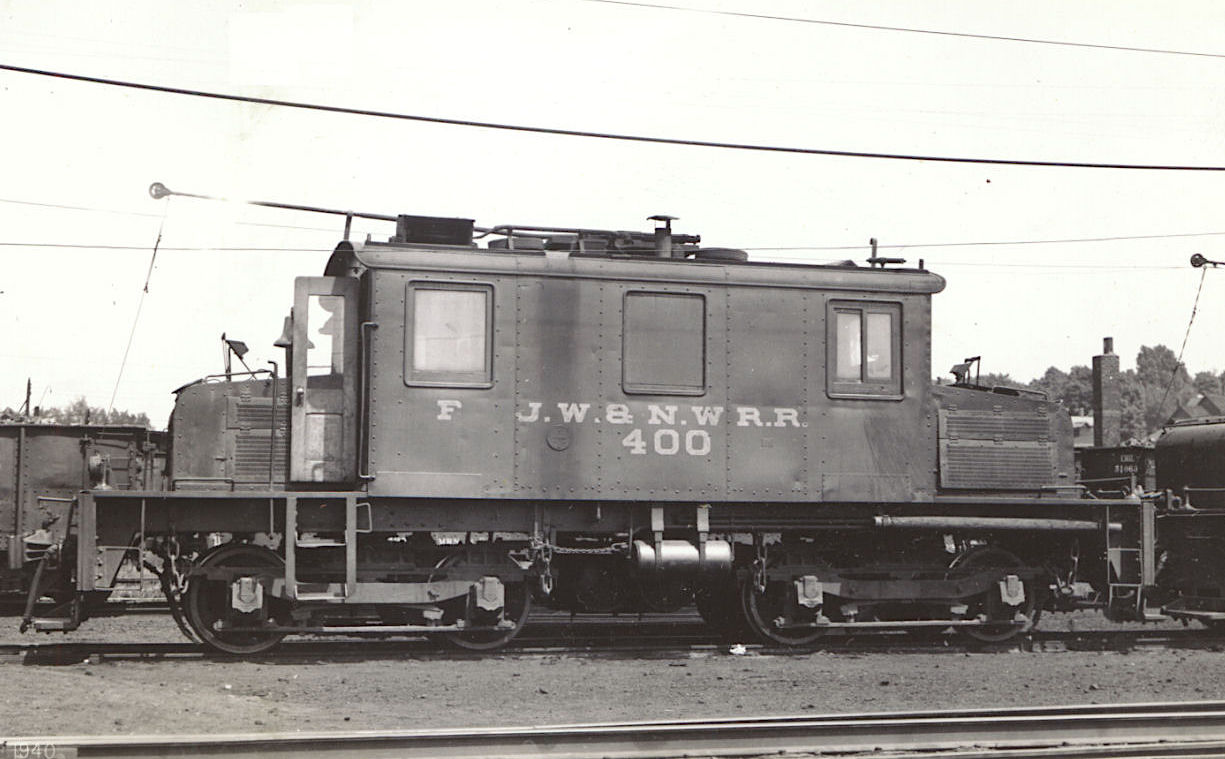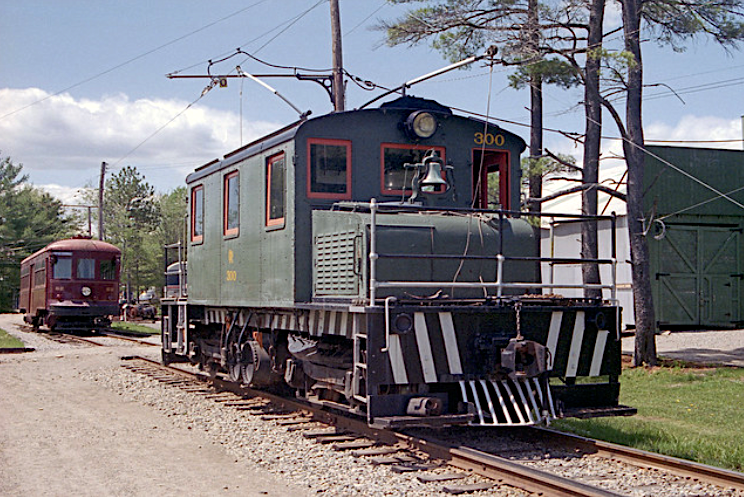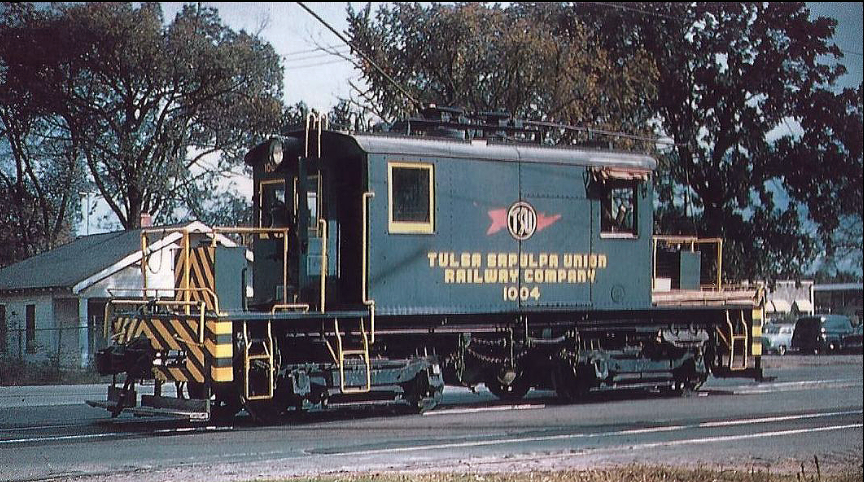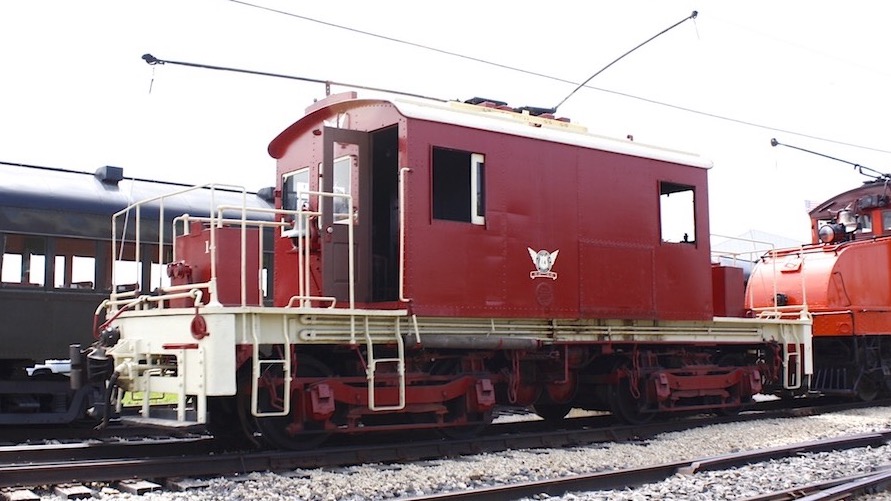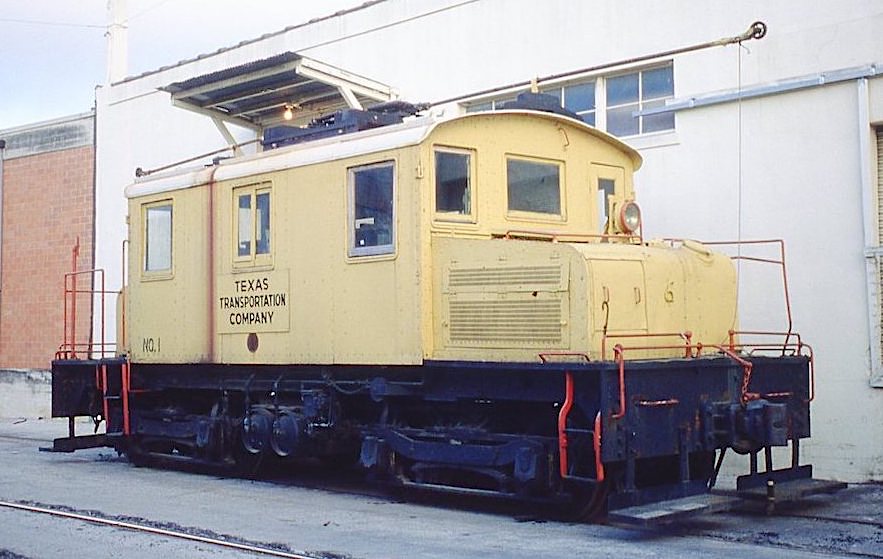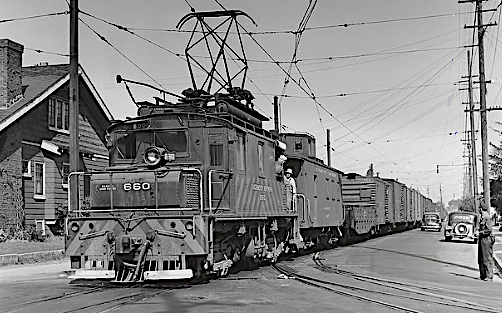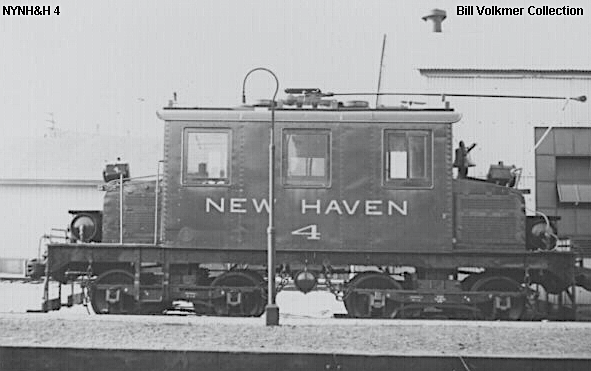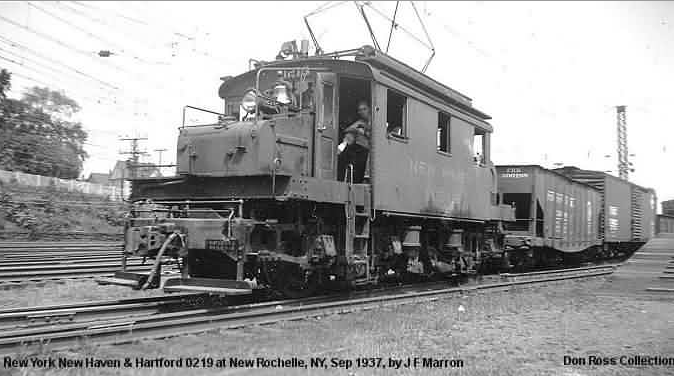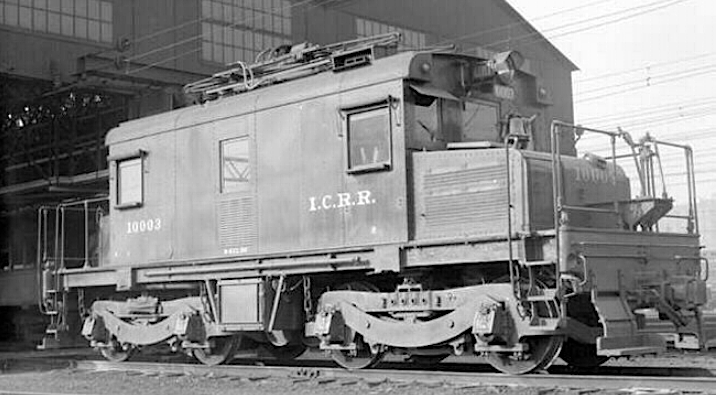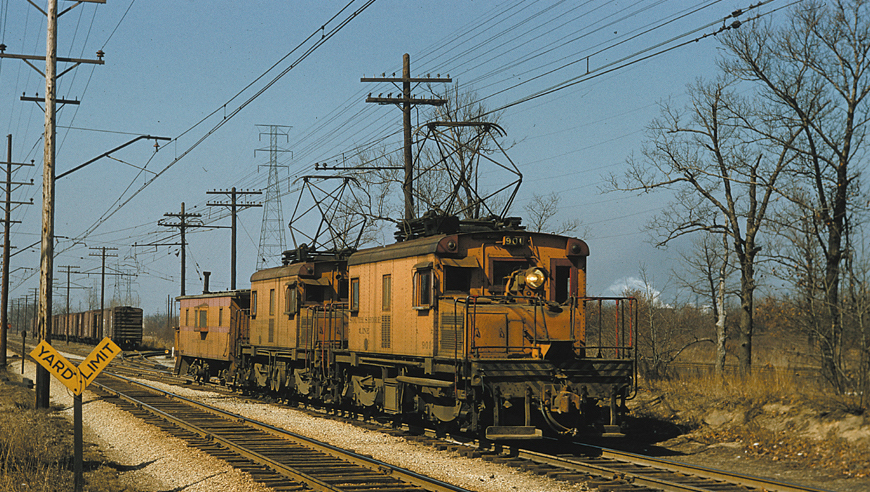BLW Steeple Cab Electrics
South Shore #1003 at Shops Yard (Gary, IN) on 10 March 1956. (John F. Humiston photo / Richard Humiston collection) | |||||
|---|---|---|---|---|---|
|
Baldwin Locomotive Works was a leading builder of locomotives for more than 130 years. The
Pennsylvania-based manufacturer had two plants, one in Philadelphia (built 1835) and the
other in Eddystone (1907). Collectively, they produced some of this nation's most notable
steam-driven and diesel-electric machines to ever grace the steel rail. During the early
1900s, the Philadelphia facility was also the epic center for electric freight motor construction.
Initially, BLW-built steeple cabs of the 1890s bore a close resemblance to electric freight
motors bearing the GE builder plate. However early in the 1900s, the Baldwin steeple cab
underwent a major redesign that encompassed a much larger center cab, along with two short
stubby-looking end hoods, which generally contained air compressors, blowers, blower motors
and sand boxes. The center cab typically housed one or two operator control stations, meter
board, gauges and other electrical gear. The change was in direct contrast to the the long
sloping end hoods of GE models, and the reconfiguration of the car-body made it easier to
distinguish BLW-built models from those with an Erie builder plate.
It was around the same period that Baldwin adopted a model classification system predicated
generally on locomotive weight and horsepower rating:
Baldwin relied heavily on Westinghouse for the supply of electrical apparatus, traction motors
and control systems. Traction motors could be sized for 600, 750, 1200 or 1500 volts, depending
on the customer specifications. The same applies to trolley poles, pantographs or third-rail
pick-up shoes. The Baldwin / Westinghouse relationship which had began during the years of
early steam engine production, lasted until the Eddystone plant ceased locomotive production
in 1956.
Another appreciable difference, Baldwin-built steeple cabs were most commonly relegated to
small railroads or interurban lines; seldom were they found working in what might be deemed
a heavy industrial setting.
Footnote: A selling feature of EMD's celebrated 1350-hp FT of 1939 was a "building block"
approach to achieving a 2700-hp or 4050-hp locomotive. Interestingly, a lash-up of two or
three m/u'd Baldwin-built Class "E" steeple-cabs had surpassed that goal thirteen years
earlier. Moreover, EMD would not introduce the 1500-hp GP7 until 1949. | |||||
* * * Baldwin-built Steeple Cab Portfolio * * *
The first production electric freight motor to bear the Baldwin-Westinghouse imprint was Metropolitan Street Railway of Toronto #1. Resembling one of the chief competitor's steeple-cabs with long sloping end hoods; the 22.5-ton electric was built in 1899. (Photographer and date of image unknown.) |
Capitol Transit #054 was a 27-ton electric motor that reflects Baldwin- Westinghouse's shift from producing locomotives with long sloping end hoods in favor of creating a larger cab area. Built in 1906, this freight motor was originally delivered to the Hoboken Shore Railway as #3. (Dave Witty collection, photographer unknown) | ||||||
Jamestown Westfield & Northwestern #400 typifies a standard Class "B" Baldwin electric of 1914/1915. The locomotive rode on rigid-bolster trucks, with type 582 FD5 traction motors, each with a 100-hp rating; the T/Ms were direct geared and axle mounted. Power for the 36-foot-long freight motor used three-phase, 600-volt AC from a single trolley pole. (Photographer unknown / Tom Starr collection) |
Oshawa Railway's locomotive roster consisted of ten freight motors; only two of which came direct from the manufacturer. The others were acquired second-hand or built by OR's own shop. The 50-ton #300 was built by BLW in 1920 and delivered to the Oshawa Rwy in 1923, after the original buyer defaulted. It remained in service for more than four decades before going to the Seashore Trolley Museum. (Dave Pirmann photo) | ||||||
By the late 1920s, the market for new electric freight motors experienced a significant decline. The Baldwin-Westinghouse reaction took the form of a scaled-back version of its standard steeple cab. Tulsa Sapulpa Union #1004 illustrates the boxy appearance and lack of short end hoods. TSU was built in 1928 for Sand Springs railroad. (Photo courtesy of TransPress NZ) |
Baldwin produced only thirteen Class B-1 freight motors (9 for CSR and 4 IC). The lack of short-end hoods dictated relocation of mechanical equipment to inside the center cab. Prior to donning the red attire of CSR #14 had been owned by Springfield Railway. Built in 1929, CSR #14 now resides at the Illinois Railway Museum. (Tim Fennell photo) |
||||||
|
|
||||||
|
|
According to some accounts, the New Haven
railroad operated one of the largest stables of electric freight motors, from small steeple
cabs to 4000-hp rectifier locomotives. The two photos immediately above depict different
types of Baldwin-built steeple cabs on the NH roster. Built in 1914, NH #4 was a modest
30-ton unit with 36" wheels (indicative of its low horsepower rating). The other NH freight
motor was constructed three years earlier and tipped the scales at 80 tons, with a 520-hp
output.
Joshua Moldover provided this additional info. "With regard to Westinghouse/Baldwin-designed electrics (and the order is deliberate; Baldwin for most was to build the carbody, with Westinghouse being the primary designer, especially when it came to AC-powered locomotives), all but a small handful (from GE) of New Haven electric locomotives built before 1930 came from that combination of companies. Of course, after 1930 it was the other way around, with all but a handful coming from GE." (Both photos courtesy of Don Ross and his Don's Depot website) |
|||||
|
|
Based on several photo library and roster searches, the Baldwin-Westinghouse team built very few Class "E" freight motors. The two photos above were the only ones to surface during the hunt. Coincidently, the pictures are of the same locomotive; 97-ton Illinois Central #10003, which was sold to Chicago South Shore and became #903. The left scene depicts IC #1003 in Chicago (Otto Perry photo / courtesy Denver Public Library), while the other scene shows Chicago South Shore #903 at Goff Junction in Gary, Indiana. (John F. Humiston photo / Richard Humiston collection) | |||||
| Notes & Credits:
Reference sources:
| |||||||
